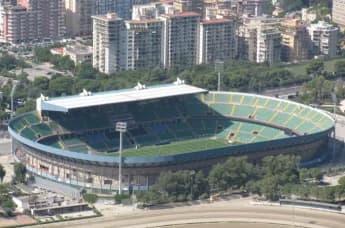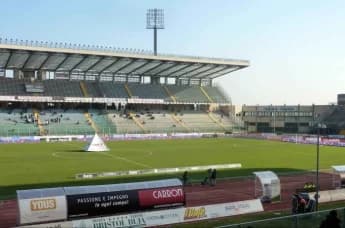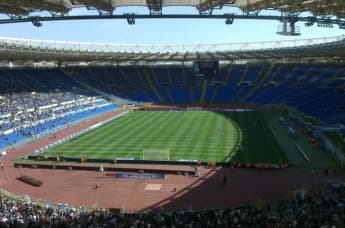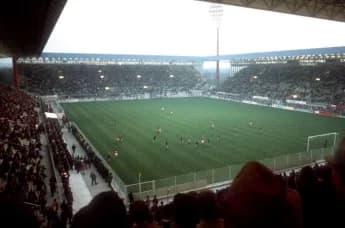Estadio Azteca stands as a monumental landmark in football culture, renowned for hosting legendary matches and continuing to unite fans from around the globe in the vibrant heart of Mexico City.
Nestled in the lively city of Mexico City, Estadio Azteca is not only the largest football stadium in Latin America but also ranks among the most iconic in the world. Boasting a capacity of 87,523 spectators, it serves as a hallmark of football culture, accommodating both the local powerhouse, Club América, and the Mexico national team. Located at an elevation of 2,200 meters (7,200 feet) above sea level, the stadium provides fans with a distinctive atmosphere that heightens the excitement of every match.
Conceived by the celebrated architects Pedro Ramírez Vázquez and Rafael Mijares Alcérreca, the construction of the venue commenced in 1961 and it officially opened in 1966. It swiftly emerged as an emblem of Mexico’s dedication to sporting excellence, harmoniously combining contemporary architecture with the vibrant spirit of the Mexican populace.
As one of the most significant and celebrated football stadiums in the world, Estadio Azteca remains a vital part of major football events, going beyond the definition of a mere stadium. This historic site embodies the essence of international football and the broader culture of sports.
Legendary Matches
The rich history of Estadio Azteca is marked by numerous iconic matches that have taken place within its confines, solidifying its reputation as a legendary football venue. The stadium is famous for hosting two FIFA World Cup finals: the first in 1970, where Brazil claimed victory over Italy with a score of 4–1, and the second in 1986, when Argentina triumphed over West Germany 3–2. These finals are firmly embedded in the annals of football history, with the stadium serving as the backdrop for some of the sport's most memorable moments.
One of the most celebrated matches in the stadium's history took place during the quarterfinals of the 1986 World Cup, where Argentina took on England. The game featured Diego Maradona’s remarkable 'Hand of God' goal and his famous 'Goal of the Century,' both of which are considered among the most iconic moments in football history. Estadio Azteca served as the backdrop for these unforgettable goals, further cementing its status as a venue where history is crafted.
In addition to hosting World Cup finals, the stadium has been the site of many unforgettable matches, including the 1970 semifinal featuring Italy and West Germany, famously dubbed the 'Game of the Century.' This exhilarating match ended with a 4–3 win for Italy, witnessed by a passionate crowd, which further solidified the stadium's reputation as a historic arena for remarkable football moments.
Amenities & Offerings
The design and facilities of Estadio Azteca distinguish it from other football stadiums worldwide. Over the years, the venue has undergone multiple renovations to remain at the forefront of modern sports infrastructure while preserving its historical appeal. As part of a comprehensive renovation in 2015, modern Panasonic LED panels were installed at both the north and south ends of the stadium.
The stadium features an extensive seating layout that guarantees an excellent view of the field for every fan. With the ability to accommodate over 87,000 spectators, the impressive scale of the venue provides an exhilarating experience, allowing fans to truly feel the excitement of the environment, no matter if they are positioned near the field or further back in the stands.
Besides its seating arrangements, Estadio Azteca boasts cutting-edge facilities, featuring VIP boxes, luxurious suites, and contemporary media areas, all crafted to enhance the experience of fans. These amenities provide attendees with an unmatched view of the game while enjoying premium services.
Significance in History
Since its inception, Estadio Azteca has stood as a pivotal landmark in the realm of international football. Being the first stadium to host two FIFA World Cup finals firmly established its significance in the global football narrative. The finals of 1970 and 1986 are not merely high points in the tournament's history, but are also foundational moments in the sport itself, showcasing some of the most iconic footballers of all time.
The stadium also played an important role during the 1968 Summer Olympics by hosting the football final, which further solidified its reputation as a premier sports venue. In addition to its football legacy, Estadio Azteca has become a cultural icon, hosting major events such as concerts by Michael Jackson, U2, and Paul McCartney, among others, demonstrating that the stadium goes beyond just sports.
For the Mexican national team, Estadio Azteca has stood as a stronghold and a source of pride where significant victories have taken place. It continues to be the preferred venue for the national team's most crucial matches, highlighting its significance in the cultural and historical landscape of sports in Mexico and beyond.
Future Events
As we look to the future, Estadio Azteca is poised to maintain its legacy of hosting international football events, with the 2026 FIFA World Cup approaching. The stadium has been chosen to host the tournament's opening match, making it the extraordinary venue that will be involved in the World Cup for the third time.
Beyond the World Cup, this stadium is set to host a variety of matches, including group stage and knockout games, as the tournament progresses through the United States, Canada, and Mexico. This represents a notable landmark in the history of the stadium, reinforcing its status as one of the foremost football venues in the world.
Preparations for these events will include renovations aimed at improving the stadium's infrastructure, such as upgraded seating and a refreshed exterior. These enhancements will ensure that Estadio Azteca remains a leading venue in the global football arena, poised to host fans for yet another era of memorable matches.
Spectator Experience
Attending an event at Estadio Azteca is an exhilarating experience. This grand stadium, steeped in history and featuring breathtaking views, creates a distinctive atmosphere that blends excitement, tradition, and cultural pride. Whether witnessing Club América in action against their rivals or watching the national team compete on an international level, fans are immersed in a vibrant environment that is hard to find in any other venue.
The venue is thoughtfully designed with the fan experience in mind, providing a variety of facilities that enhance each matchday. Within the stadium, there are numerous food and drink options, merchandise stands, and fan zones where supporters can connect with the team's history before the game begins.
For those participating in international events, the atmosphere is enhanced, as fans from across the globe gather to witness history unfold. Estadio Azteca's capability to host both sports and cultural events establishes it as a truly exceptional venue, where the experience transcends the match itself.
Nestled in the lively city of Mexico City, Estadio Azteca is not only the largest football stadium in Latin America but also ranks among the most iconic in the world. Boasting a capacity of 87,523 spectators, it serves as a hallmark of football culture, accommodating both the local powerhouse, Club América, and the Mexico national team. Located at an elevation of 2,200 meters (7,200 feet) above sea level, the stadium provides fans with a distinctive atmosphere that heightens the excitement of every match.
Conceived by the celebrated architects Pedro Ramírez Vázquez and Rafael Mijares Alcérreca, the construction of the venue commenced in 1961 and it officially opened in 1966. It swiftly emerged as an emblem of Mexico’s dedication to sporting excellence, harmoniously combining contemporary architecture with the vibrant spirit of the Mexican populace.
As one of the most significant and celebrated football stadiums in the world, Estadio Azteca remains a vital part of major football events, going beyond the definition of a mere stadium. This historic site embodies the essence of international football and the broader culture of sports.
Legendary Matches
The rich history of Estadio Azteca is marked by numerous iconic matches that have taken place within its confines, solidifying its reputation as a legendary football venue. The stadium is famous for hosting two FIFA World Cup finals: the first in 1970, where Brazil claimed victory over Italy with a score of 4–1, and the second in 1986, when Argentina triumphed over West Germany 3–2. These finals are firmly embedded in the annals of football history, with the stadium serving as the backdrop for some of the sport's most memorable moments.
One of the most celebrated matches in the stadium's history took place during the quarterfinals of the 1986 World Cup, where Argentina took on England. The game featured Diego Maradona’s remarkable 'Hand of God' goal and his famous 'Goal of the Century,' both of which are considered among the most iconic moments in football history. Estadio Azteca served as the backdrop for these unforgettable goals, further cementing its status as a venue where history is crafted.
In addition to hosting World Cup finals, the stadium has been the site of many unforgettable matches, including the 1970 semifinal featuring Italy and West Germany, famously dubbed the 'Game of the Century.' This exhilarating match ended with a 4–3 win for Italy, witnessed by a passionate crowd, which further solidified the stadium's reputation as a historic arena for remarkable football moments.
Amenities & Offerings
The design and facilities of Estadio Azteca distinguish it from other football stadiums worldwide. Over the years, the venue has undergone multiple renovations to remain at the forefront of modern sports infrastructure while preserving its historical appeal. As part of a comprehensive renovation in 2015, modern Panasonic LED panels were installed at both the north and south ends of the stadium.
The stadium features an extensive seating layout that guarantees an excellent view of the field for every fan. With the ability to accommodate over 87,000 spectators, the impressive scale of the venue provides an exhilarating experience, allowing fans to truly feel the excitement of the environment, no matter if they are positioned near the field or further back in the stands.
Besides its seating arrangements, Estadio Azteca boasts cutting-edge facilities, featuring VIP boxes, luxurious suites, and contemporary media areas, all crafted to enhance the experience of fans. These amenities provide attendees with an unmatched view of the game while enjoying premium services.
Significance in History
Since its inception, Estadio Azteca has stood as a pivotal landmark in the realm of international football. Being the first stadium to host two FIFA World Cup finals firmly established its significance in the global football narrative. The finals of 1970 and 1986 are not merely high points in the tournament's history, but are also foundational moments in the sport itself, showcasing some of the most iconic footballers of all time.
The stadium also played an important role during the 1968 Summer Olympics by hosting the football final, which further solidified its reputation as a premier sports venue. In addition to its football legacy, Estadio Azteca has become a cultural icon, hosting major events such as concerts by Michael Jackson, U2, and Paul McCartney, among others, demonstrating that the stadium goes beyond just sports.
For the Mexican national team, Estadio Azteca has stood as a stronghold and a source of pride where significant victories have taken place. It continues to be the preferred venue for the national team's most crucial matches, highlighting its significance in the cultural and historical landscape of sports in Mexico and beyond.
Future Events
As we look to the future, Estadio Azteca is poised to maintain its legacy of hosting international football events, with the 2026 FIFA World Cup approaching. The stadium has been chosen to host the tournament's opening match, making it the extraordinary venue that will be involved in the World Cup for the third time.
Beyond the World Cup, this stadium is set to host a variety of matches, including group stage and knockout games, as the tournament progresses through the United States, Canada, and Mexico. This represents a notable landmark in the history of the stadium, reinforcing its status as one of the foremost football venues in the world.
Preparations for these events will include renovations aimed at improving the stadium's infrastructure, such as upgraded seating and a refreshed exterior. These enhancements will ensure that Estadio Azteca remains a leading venue in the global football arena, poised to host fans for yet another era of memorable matches.
Spectator Experience
Attending an event at Estadio Azteca is an exhilarating experience. This grand stadium, steeped in history and featuring breathtaking views, creates a distinctive atmosphere that blends excitement, tradition, and cultural pride. Whether witnessing Club América in action against their rivals or watching the national team compete on an international level, fans are immersed in a vibrant environment that is hard to find in any other venue.
The venue is thoughtfully designed with the fan experience in mind, providing a variety of facilities that enhance each matchday. Within the stadium, there are numerous food and drink options, merchandise stands, and fan zones where supporters can connect with the team's history before the game begins.
For those participating in international events, the atmosphere is enhanced, as fans from across the globe gather to witness history unfold. Estadio Azteca's capability to host both sports and cultural events establishes it as a truly exceptional venue, where the experience transcends the match itself.







